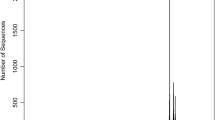Abstract
Cultured Apostichopus japonicus in China suffers from a kind of skin ulceration disease that has caused severe economic loss in recent years. The disease, pathogens of which are supposed to be bacteria by most researchers, is highly infectious and can often cause all individuals in the same culture pool to die in a very short time. The 16S rRNA gene phylogenesis of the culturable bacteria from the lesions of diseased individuals was conducted to study the biodiversity of the bacterial communities in the lesions and to identify probable pathogen(s) associated with this kind of disease. S. japonica samples were selected from a hatchery located in the eastern part of Qingdao, China. Bacterial universal primers GM5F and DS907R were used to amplify the 16S rRNA gene of bacteria colonies, and touchdown PCR was performed to amplify the target sequences. The results suggest that γ- proteobacteria (Alteromonadales and Vibrionales) of CFB group, many strains of which have been also determined as pathogens in other marine species, are the predominant bacterial genera of the diseased Apostichopus japonicus individuals.
Similar content being viewed by others
References
Avendano-Herrera, R., Toranzo, A. E., Romalde, J. L., Lemos, M. L., and Magarinos, B., 2005. Iron uptake mechanisms in the fish pathogen Tenacibaculum maritimum. Appl. Environ. Microbiol., 71(11): 6947–6953.
Bakunina, I., Nedashkovskaia, O. I., Alekseeva, S. A., Ivanova, E. P., Romanenko, L. A., Gorshkova, N. M., et al., 2002. Degradation of fucoidan by the marine proteobacterium Pseudoalteromonas citrea. Mikrobiologiia, 71(1): 49–55.
Bakunina, I., Shevchenko, L. S., Nedashkovskaia, O. I., Shevchenko, N. M., Alekseeva, S. A., Mikhailov, V. V., et al., 2000. Screening of marine bacteria for fucoidan hydrolases. Mikrobiologiia, 69(3): 370–376.
Becker, P., Gillan, D., Lanterbecq, D., Jangoux, M., Rasolofonirina, R., Rakotovaod, J., et al., 2004. The skin ulceration disease in cultivated juveniles of Holothuria scabra (Holothuroidea, Echinodermata). Aquaculture, 242: 13–30.
Bernardet, J. F., and Kerouault, B., 1989. Phenotypic and genomic studies of ‘Cytophaga psychrophila’ isolated from diseased rainbow trout (Oncorhynchus mykiss) in France. Appl. Environ. Microbiol., 55(7): 1796–1800.
Crump, E. M., Perry, M. B., Clouthier, S. C., and Kay, W. W., 2001. Antigenic Characterization of 255 the Fish Pathogen Flavobacterium psychrophilum. Appl. Environ. Microbiol., 67(2): 750–759.
Devesa, S., Barja, J. L., and Toranzo. A. E., 1989. Ulcerative skin and fin lesions in reared turbot, Scophthalmus maximus (L.). J. Fish Dis., 12: 323–333.
Farto, R., Armada, S. P., Montes, M., Guisande, J. A., Perez, M. J., and Nieto, T. P., 2003. Vibrio lentus associated with diseased wild octopus (Octopus vulgaris). J. Invertebr. Pathol., 83(2): 149–156.
Gilles, K.W., and Pearse, J. S., 1986. Disease in sea urchins Strongylocentrotus purpuratus: experimental infection and bacterial virulence. Dis. Aquat. Org., 1: 105–114.
Gomez, L. J., Villamil, L., Lemos, M. L., Novoa, B., and Figueras, A., 2005. Isolation of Vibrio alginolyticus and Vibrio splendidus from aquacultured carpet shell clam (Ruditapes decussatus) larvae associated with mass mortalities. Appl. Environ. Microbiol., 71(1): 98–104.
Ivanova, E. P., Sawabe, T., Zhukova, N. V., Gorshkova, N. M., Nedashkovskaya, O. I., Hayashi, K., et al., 2003. Occurrence and diversity of mesophilic Shewanella strains isolated from the North-West Pacific Ocean. Syst. Appl. Microbiol., 26(2): 293–301.
Jangoux, M., 1990. Iseases of echinodermata. In: Diseases of Marine Animals. Vol.3. Kinne, O., ed., Biologische Anstalt Helgoland, Hamburg, Germany, 439–567.
Jukes, T. H., and Cantor, C. R., 1969. Evolution of protein molecules. In: Mammalian Protein Metabolism. Munro, H. N. ed., Academic Press, New York, USA, 21–132.
Lumsden, J. S., Ostland, V. E., MacPhee, D. D., and Ferguson, H. W., 1995. Production of a gill282 associated and serum antibody by rainbow trout (Oncorhynchus mykiss) following immersion immunisation with acetone-killed Flavobacterium branchiophilum and the relationship to protection from experimental challenge. Fish Shellfish Immunol., 5: 151–165.
Morgan, A. D., 2000. Aspects de la gestion des stocks géniteurs d’holothuries de sable (Echinoderme: Holothurides). La Bêche-de-mer Bulletin d’information. Vol. 13. Secrétariat général de la Communauté du Pacifique, 2–8.
Sawabe, T., Tanaka, R., Iqbal, M. M., Tajima, K., Ezura, Y., Ivanova, E. P., et al., 2000. Assignment of Alteromonas elyakovii KMM 162T and five strains isolated from spot-wounded fronds of Laminaria japonica to Pseudoalteromonas elyakovii comb. nov. and the extended description of the species. Int. J. Syst. Evol. Microbiol., 1: 265–271.
Sugumar, G., Nakai, T., Hirata, Y., Matsubara, D., and Muroga, K., 1998. Vibrio splendidus biovar II as the causative agent of bacillary necrosis of Japanese oyster Crassostrea gigas larvae. Dis. Aquat. Org., 33(2): 111–118.
Suzuki, M., Nakagawa, Y., Harayama, S., and Yamamoto, S., 2001. Phylogenetic analysis and taxonomic study of marine Cytophaga-like bacteria: proposal for Tenacibaculum gen. nov. with Tenacibaculum maritimum comb. nov. and Tenacibaculum ovolyticum comb. nov., and description of Tenacibaculum mesophilum sp. nov. and Tenacibaculum amylolyticum sp. nov. Int. J. Syst. Evol. Microbiol., 51: 1639–1652.
Swofford, D., 1998. PAUP: Phylogenetics Analysis Using Parsimony (*and others methods). Version 4.0b10. Sinauer Associates, Sunderland, Massachussetts.
Teske, A., Wawer, C., Muyzer, G., and Ramsing, N. B., 1996. Distribution of sulfate-reducing bacteria in a stratified fjord (Mariager Fjord, Denmark) as evaluated by most-probable-number counts and denaturing gradient gel electrophoresis of PCR-amplified ribosomal DNA fragments. Appl. Environ. Microbiol., 2: 1405–1415.
Thompson, J. D., Higgins, D. G., Gibson, T. J., and Clustal, W., 1994. Improving the sensitivity of progressive multiple sequence alignment through sequence weighting, positions specific gap penalties and weight matrix choice. Nucleic Acids Res., 22: 4673–4680.
Urvantseva, A. M., Bakunina, I., Nedashkovskaia, O. I., Kim, S. B., and Zviagintseva, T. N., 2006. Distribution of intracellular fucoidan hydrolases among marine bacteria of the family Flavobacteriaceae. Prikl. Biokhim. Mikrobiol., 42(5): 552–559.
Wang, Y., Rong, X., Zhang, C., and Sun, S., 2005. Main diseases of cultured Apostichopus japonicus: prevention and treatment. Mar. Sci., 29(3): 1–7.
Author information
Authors and Affiliations
Corresponding author
Rights and permissions
About this article
Cite this article
Ma, H., Jiang, G., Wu, Z. et al. 16S rRNA gene phylogenesis of culturable predominant bacteria from diseased Apostichopus japonicus (Holothuroidea, Echinodermata). J. Ocean Univ. China 8, 166–170 (2009). https://doi.org/10.1007/s11802-009-0166-x
Received:
Revised:
Accepted:
Published:
Issue Date:
DOI: https://doi.org/10.1007/s11802-009-0166-x




